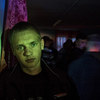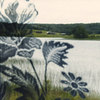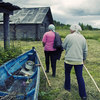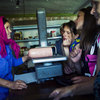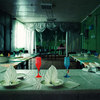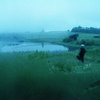A Conversation with CPC 2010 Winner Oksana Yushko
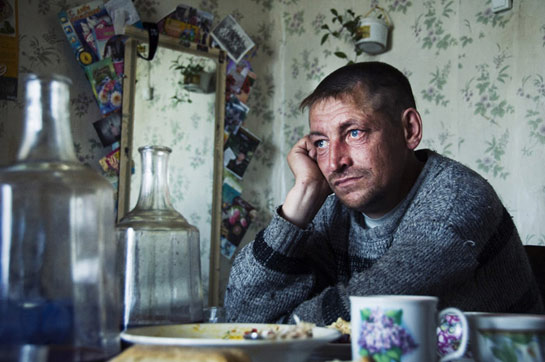
Oksana Yushko is one of the winners of this year’s Conscientious Portfolio Competition. About her work, juror Susanna Brown wrote: “Oksana Yushko’s project Kenozero Dreams reveals both the beauty and banality of life for the inhabitants of Kenozero in Nothern Russia. We glimpse a place that has remained relatively unchanged for decades and an atmosphere of longing, of waiting. The landscape and portrait images are equally evocative, but for me the most memorable photograph in this series depicts two teenagers in a field, collecting flowers in the twilight haze. Dressed in modern clothes they carry out an ancient pagan rite. The boy’s gaze is transfixed, balancing a delicate wreath of flowers on his baseball cap he stares into the gloaming, and perhaps into his own future.” In the following conversation, I talk with Oksana about her work. (more)
Jörg Colberg: I can’t not ask about this first: Your bio states that you have a background in computer science and mathematics. How did you get interested in photography?
Oksana Yushko: Since my childhood I always have been very open to everything what was around me, so I was interested in mathematics, music, literature, arts, nature, people… And it was easy for me to switch between all of my interests. A lot of people just follow the plan in their mind and choose just one thing. For me it couldn’t be just one. And anyway it is about the tool with which to study the world. Photography is a great instrument for this. But mathematics was a great way to start, to do things systematically and to make me to use my brains.
JC: Coming to Kenozero Dreams - can you give us a little bit of background about the project? How did you decide to take photographs there?
OY: I currently live in Moscow. It’s a huge metropolis. Living here you get used to people, speed, vanity, the subway… Do you know that the subway is a whole individual city of people inside Moscow? And when you come to any village in the north of Russia, like Kenozero, you meet the silence. There, you meet amazing people, you are surrounded by the beauty of nature, and you just shoot the first picture and that’s it. You see to it that you will come back there again and again. You listen to these people, their stories, their dreams and you need nothing else. For me, it just happened that way.
Most of villages in the Kenozero region are abandoned now, and people come there just during the Summer to spend their holidays. The area is lost in the forest, with access using awful roads. Nothing extraordinary is happening there. People live their daily life, they have been used to unemployment and bad social conditions for a long time. Most of them have no job, or they have to go to the work to the nearest town.
During the Soviet era, people in Kenozero used to cut timber and earned their living that way. In 1991 the region became a national park and cutting timber was forbidden. Everything was ruined. But maybe that wasn’t the actual reason or at least it wasn’t the only reason of the decline of the region.
The lives of the people were broken, and they had to decide - stay there or leave. Most of the young people chose to leave their native villages and to try their luck somewhere else. The people who stayed live on subsistence farming, fishing, hunting, they go to the hospital in the nearest town.
But they are still generous, kind, have open hearts, and they still have dreams. It’s amazing to speak with them about their dreams and hopes while they are cutting grass in a field or fishing or shopping in the only grocery store. They are simple people, and only simple values make sense for them.
JC: And how typical is what can be seen in the area for what is currently going on in Russia in general?
OY: Recently, on assignment for Russian Reporter magazine, I went to various other villages in Russia. The subject of our investigation was exactly what is going on in Russian villages right now. It made me realize that people all over rural Russia have almost the same lives, the same hopes, the same expectations. So in a way, Kenozero, as picturesque as it is, for me is a showcase of the Russian countryside.
JC: How are those rural hopes or expectations different from what you find in the cities? Are there different?
OY: Do you know the saying ‘you are what you eat’? Here it is the same thing: ‘you are what you see’. I mean the mental outlook. As I said before people in villages have simple values and their hopes are to have a good family, a husband who won’t drink, to earn enough money, to have children, to bring up them well and so on.
People in the cities want the same things, and they just add some things like “I want to have a new TV set/refrigerator/car etc.”, “I want to spend vacations abroad”, “I want to be a movie star/singer/actor etc.” And they have a bit more opportunities to realize their dreams.
JC: You’ve done a lot of work in dangerous areas, such as Grozny. What are the conditions for photojournalists or photographers, working in Russia, on assignments to such areas? There are many stories of journalists having problems, some of them even getting killed in Russia.
OY: Right now, Grozny is not a hot zone. When you come to Chechnya you should respect the rules and traditions, and probably one of the difficulties is that you feel such a big difference between the cultures although Chechnya is part of Russia. The rest is your evaluation of the situation around you.
Speaking about the killed journalists in Russia, the majority of them were killed in Moscow, please take a look at a recent photo project by Ludmila Zinchenko, Casually murdered.
JC: You’re a member of Verso Images, a collective of five emerging Russian documentary photographers, concentrating “on making stories of social changes in Russia and [the] former USSR.” How did Verso get started?
OY: In 2008-2010 me, Olga Kravets and Maria Morina were part of
Objective Reality online workshops for emerging photographers. At some point, around eight people from the seminar, including us, decided to meet offline. The meetings became regular and we decided to do something together. But then, as often happens in big groups, people lost inspiration. The three of us kept meeting, and that was the beginning of our joint project Grozny: Nine Cities in Chechnya, which we are working on now. This is how the collective work de facto started. But at the same time, since September 2009 with Alexander Sedelnikov and Viktor Yuliev we have been nursing the idea of the photography collective, something totally unknown in Russia. First it was Alexander, who suggested we should unite, but it took us a while to figure out a form. Late last year Verso was finally launched.
As a collective we are trying to exchange some ideas and thoughts, to help each other. Of course, we are going to shoot a collaborative project together, and we hope to create some innovative products which are definitely easier to do together.
JC: How has the collective work out so far? Has it been tricky or easy to find assignments? And do you plan to include new members, maybe even non-Russian ones?
OY: So far, our collective work is our book project Grozny: Nine Cities, which is due to be finished in the middle of 2011, and then we will consider other projects. The tricky part is to be published as a group of three, but we are sure once the work is finished, this problem will be solved.
Regarding the new members, we think it is a matter of time. It does not matter where they would come from, they just have to be people we fully trust. But right now, you know, we are very young as a collective, we have to first establish ourselves as a group.
 By
By 